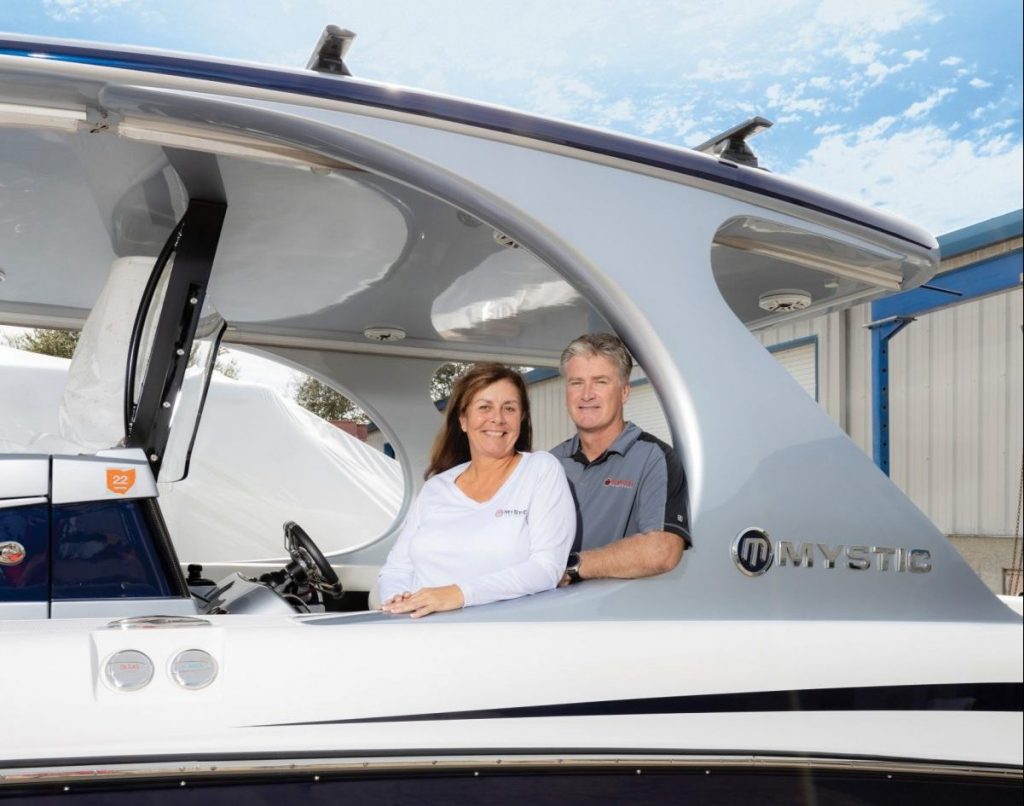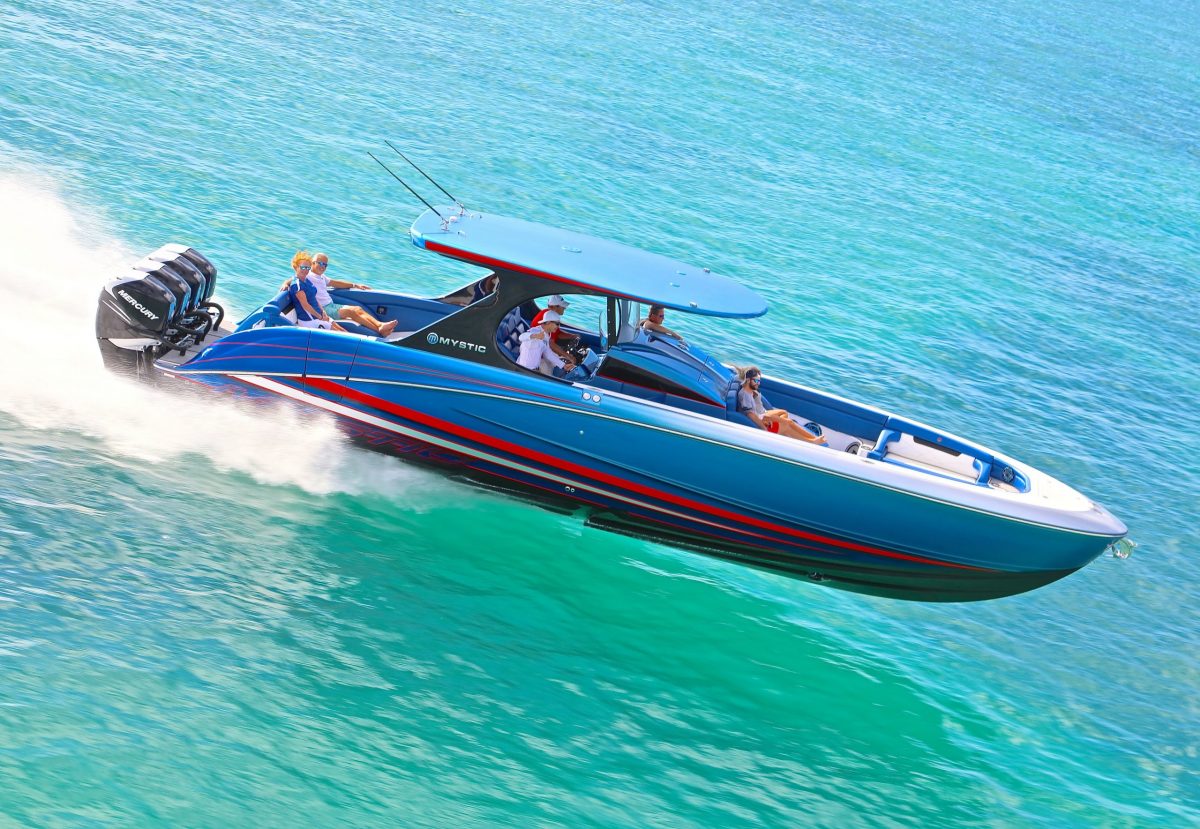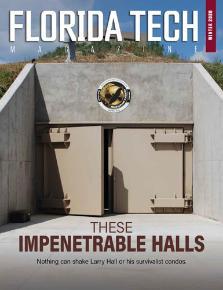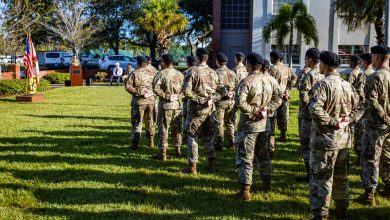Mystic Powerboats: Alumni Passion Fuels Rapidly Expanding Performance Boat Business
John Cosker ’91 was 8 years old when he saw it: a 38-foot Formula performance boat.
Zipping across Cape Cod Bay, it was unlike any boat he had ever seen. As a Connecticut boy, who since age 5 had clocked countless hours fishing on the bay and on Long Island Sound in his father’s boat, Cosker had seen a lot of watercraft. But this was something special.
Curiosity got the best of him. Before he knew it, young Cosker was trailing the foreign vessel across the bay to a dock in Provincetown, Massachusetts, asking the captain, “What is this?”
“It was that day I became hooked on performance boats,” Cosker recalls. “From that time forward, I wanted to do exactly what I’m doing now.”

“It was that day I became hooked on performance boats. From that time forward, I wanted to do exactly what I’m doing now.”
John Cosker ’91, president and designer, Mystic Powerboats
Rooted in Racing
Cosker is the president and designer at Mystic Powerboats, the high-performance luxury powerboat brand he founded nearly 25 years ago.
Today, Mystic offers a varied line of V-hull, catamaran and center console performance and pleasure boats. Every boat it creates is unique, with options like color scheme, interior design and motor size customized to fit personal tastes.
It’s about comfort, class, luxury.
But in Mystic’s early days, it was about just one thing: speed.
The Porsches and Ferraris of the water, performance boats are known for their light weights, narrow beams and sleek designs that enable them to reach fast speeds ideal for racing.
What’s fast?
The average pleasure boat maxes out around 40 mph; 50 to 55 mph is very quick.
“We’ve never built a boat that went under 70 mph,” Cosker says.
Most “go-fast” catamarans can reach speeds between 100 and 150 mph, with the world’s second-fastest offshore catamaran manufacturer’s craft topping out at about 213 mph.
The world’s fastest: The Mystic 50, which has reached 244 mph. In fact, Mystic has built a half-dozen 50-footers that have topped 200 mph—more than all other manufacturers combined.
Also the catamaran to most consistently go over 200 mph, the Mystic 50, which was originally designed for telecommunications mogul and powerboat racer Dave Callan, has won the Lake of the Ozarks Shootout race every year but one since 2005.
Alongside Callan in the cockpit: Cosker himself.
“It kind of started out with proving the product. I was always my own crash-test dummy—there weren’t a lot of people signing up for it,” says Cosker, who today mans the cockpit on his own. “But I think it’s the adrenaline of it—in 20, 25 seconds, the whole thing is through, and I’m absolutely hooked again.”

The Mystic Difference
While there is no single secret to designing and manufacturing a world record-setting powerboat, Cosker and the Mystic crew have concocted a pretty effective formula.
With a mind set on the end goal but open to innovative methods for achieving it, Cosker quickly became a pioneer in the industry.
“I learned early on that I don’t draw well by hand, so I really needed to learn how to draw with a computer,” Cosker says. “I forced myself to do it because I thought I had to. I was lucky enough, not only that the programs and computers were available at that point, but also that I got to be one of the first people to come through the industry with that kind of background.”
Around the time that Cosker made his industry debut, so did the step-bottom hull, which he helped develop into the increasingly popular design element it is today.
Essentially a notch in the bottom of the boat, a hull step creates a pocket of air that reduces the wetted surface and, thus, friction between the boat and the water, increasing its speed.
Mystic was also one of the first builders to implement the wet bag epoxy vacuum bagging technique for manufacturing boat parts with epoxy resin. Likewise, it was one of the first to realize there had to be a better way.
“Vacuum bagging epoxy resins that are curing is really labor intensive,” Cosker says. “I had to find a different way to get the same results but with a lot fewer man-hours to be able to go to market with a reproducible boat at a reasonable price.”
In 2014, Mystic began experimenting with vacuum resin infusion. While the bagging method places resin-coated laminate in the mold before a vacuum compacts it—restricting adjustment opportunity before the resin begins to cure—infusion injects resin into an already vacuum-compacted mold lined with dry materials. The result: a lighter boat with fewer mistakes in less time.
“It’s a lot cleaner. It’s a lot easier. And it’s a lot more trainable, because you’re not racing against the clock,” he says. “It’s even a more environmentally friendly process, so a lot of builders are going that way now.”
While the design and manufacturing complexities are vital, for the speed, agility and quality of his boats, Cosker chalks it up to experience.
The Voyage
When Cosker started exploring colleges at age 16, he considered a few places in Michigan, Rhode Island and Virginia that had either ocean engineering or naval architecture programs.
Florida Tech offered both, but it was its high-speed boat and hull design courses as well as its location in the heart of the performance boat industry that sealed the deal.
“I didn’t want to design ships. I didn’t want to design barges. I won’t say Florida Tech taught me everything I needed to know to sit down and design a boat, but it gave me the basics and the analytical mindset to be able to do it,” Cosker says. “It gave me a very good foot up to work in high-speed small craft design before I even graduated.”
“I won’t say Florida Tech taught me everything I needed to know to sit down and design a boat, but it gave me the basics and the analytical mindset to be able to do it. It gave me a very good foot up to work in high-speed small craft design before I even graduated.”
John Cosker ’91, president and designer, Mystic Powerboats
In fact, he landed his first job out of college with Rolla Propellers, a Swiss marine propeller business with which he had interned while at Florida Tech.
“From Cigarette to Hatteras to yacht builders, I got to go into a lot of different boat builders with Rolla, and I learned a lot about what to do and what not to do.”
Equally important, Cosker says, were the contacts he made.
When Tom Gentry, a wealthy real estate developer with several powerboat racing world records, set out to reclaim his transatlantic record—the fastest to boat from New York to England—his project manager contacted Cosker, whom he’d been working with at Rolla, to design the craft.
Cosker moved to South Florida to join the team at Gentry Transatlantic, where he worked for about two years before Gentry passed away in a tragic boat-racing accident, and the project was canceled.
Cosker’s love for Melbourne—as well as for his then-girlfriend, now-wife and fellow Florida Tech alumna, Robin Cosker ’90—brought him back to the Space Coast, where he worked on a few freelance boat design projects until another contact reached out to him about an engineering job opportunity in Wisconsin.
A brief conversation with the front desk clerk about the brutal Wisconsin winters was Cosker’s first clue that the job wasn’t for him. His second, though, was a tour of the factory, where he quickly realized that he wasn’t cut out to work for a large corporation.
From the interview, he drove to Michigan to visit Skater Powerboats, a pioneer in offshore catamaran construction.
“I kind of just looked around, and I said, ‘You know what? I could do this.’” Cosker says.
Three weeks later, Mystic was born.

Treading Water
Since then, Cosker and the Mystic team have designed and built an impressive array of powerboats ranging from a 55-foot, 120-mph V-hull with 7,500 horsepower worth of turbine engines, a glass cockpit, fighter jet-style seating and joystick controls to a custom 70-foot diesel boat that could reach more than 80 mph.
But like any business—especially those that specialize in luxury goods—Mystic has had its ups and downs.
“The big projects were great,” Cosker says. “They were home runs when we had them, but we had a lot of dips in between.”
Engines are expensive. And having bootstrapped Mystic without any outside funding, getting started was a challenge. The Great Recession took its toll on business, too. During that time, Robin, who had left her previous job as an environmental engineer at the Kennedy Space Center to raise their two daughters, took on the bookkeeping role at Mystic, as it could no longer afford outside help.
“Robin has been by my side through it all,” Cosker says. “And there were plenty of times that we paid for our employees’ groceries when we could barely afford our own.”
So in 2014, when a dealer approached Cosker at the Miami Boat Show, suggesting that Mystic branch out of racing into center console pleasure boats, the idea of a broader market appealed to him.
Full Speed Ahead
Having previously designed center consoles for other major builders on a freelance basis, Cosker knew how to fine-tune the hull design to achieve the smooth, dry, comfortable ride important to pleasure boaters. Robin, too, provided input on how to create comfort from a female and family perspective.
“These customers still have a need for speed, and we can certainly fulfill that. But with pleasure boats, that’s not the first thing on the list,” Cosker says. “It was a big transition for us, because on the race boats, the fit and finish weren’t super critical. As long as it went fast and won, that’s all that counted.”
By 2015, Mystic had introduced a 42-foot high-performance luxury center console. Two years later, it launched a similar 38-foot version, and business has taken off as swiftly as the boats themselves.
In years past, Mystic would complete two or three boats a year. In 2018, it delivered 16 boats. Last year, production almost doubled, delivering nearly 30 boats. In those few years, Mystic went from 20-something employees to 55, and in October, from a 38,000-square-foot facility to 58,000 square feet.
To match its growing production capabilities, Mystic is also expanding its dealer network, and Cosker is at work developing new designs for a more extensive model line.
“I think no matter how long you’ve been at it and how well you’re doing, there’s still that risk. But that risk gave me the opportunity to do what I absolutely love: create things,” Cosker says. “There’s no reward without risk, and I think I probably never would have taken as much if I didn’t have such passion for this business and believe in it so much.”
This story was featured in the winter 2020 edition of Florida Tech Magazine. Read the full issue here.






